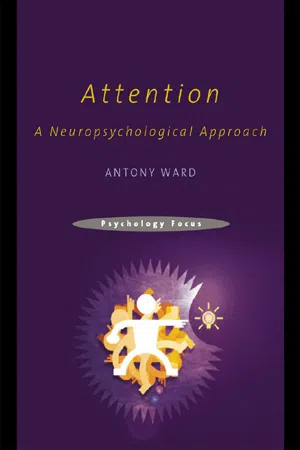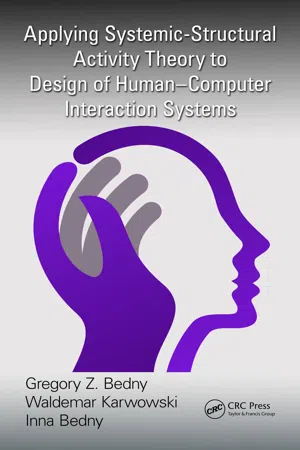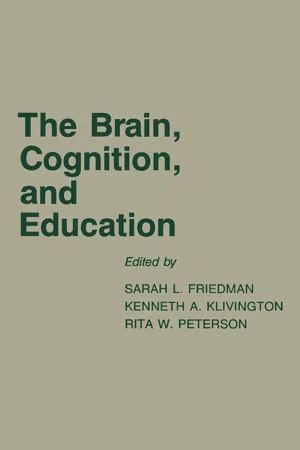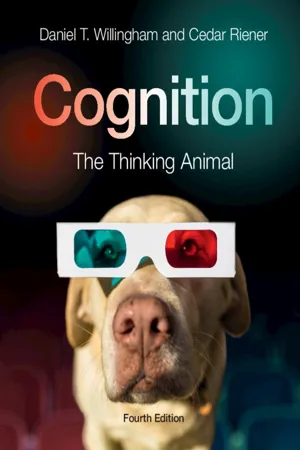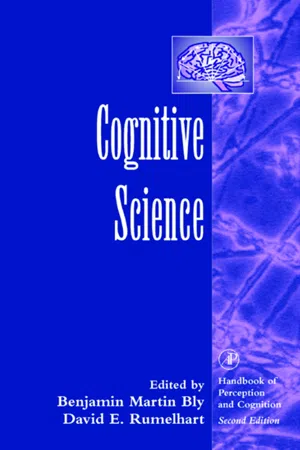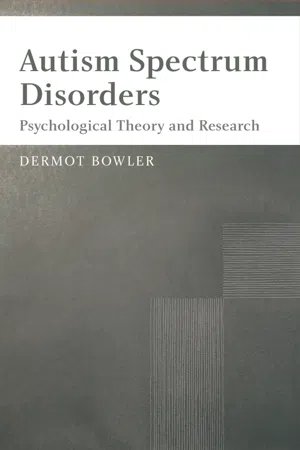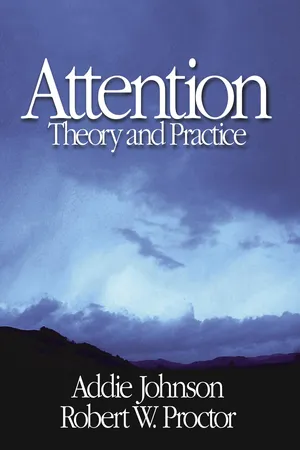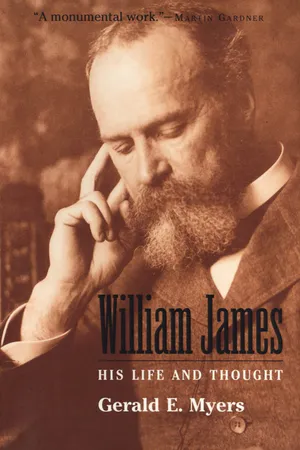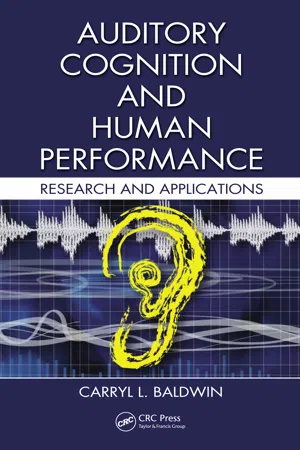Psychology
Attention
Attention refers to the cognitive process of selectively concentrating on a particular aspect of the environment while ignoring other stimuli. It involves the ability to focus on relevant information and filter out distractions. Attention is crucial for perception, learning, memory, and problem-solving, and it plays a significant role in various psychological processes.
Written by Perlego with AI-assistance
Related key terms
1 of 5
11 Key excerpts on "Attention"
- eBook - ePub
Attention
A Neuropsychological Approach
- Antony Ward(Author)
- 2004(Publication Date)
- Psychology Press(Publisher)
Chapter 1- Overview
- Introduction
- What is Attention?
- Selective Attention
- Divided Attention
- Control of Attention
- Vigilance
- Summary
—William James (1890)Everyone knows what Attention is. It is the taking possession of the mind, in clear and vivid form, of one out of what seemed several simultaneously possible objects or trains of thought. Focalization, concentration, of consciousness are of its essence.Overview
THIS CHAPTER COMMENCES with a brief introduction to the topic of Attention. It then goes on to introduce the relevant cognitive theories to the reader (or revise the concepts for those who have previously studied the subject). These theories will recur as subsequent chapters describe how they have guided research with various types of patients. Clearly, then, a good grasp of the material in this chapter will be essential to fully appreciating that presented in later chapters. Readers who are familiar with the various theories may choose to skip this chapter or concentrate on those sections that deal with unfamiliar material.Introduction
Our ability as human beings to selectively focus our Attention on specific features of our environment is undoubtedly of fundamental importance in allowing us to adapt to an ever more complex and richer world. Take a common experience, such as standing on the concourse of a major railway station or airport, and imagine all the sights and sounds bombarding your senses and demanding recognition. Were you not able to screen out some of this abundance of stimuli, then such an experience would be daunting indeed. The study of these key mental processes has become the concern of a major strand of modern psychology, the study of cognition. This area of psychology has been a major part of the discipline for over 40 years and, from the outset, the study of Attention has been an important element, for example with the publication of a highly influential work by Broadbent in 1958. Since that time, psychologists have sought to take real-world problems, such as how we deal with several sounds simultaneously, and study them in the laboratory under carefully controlled conditions. - eBook - PDF
- Gregory Z. Bedny, Waldemar Karwowski, Inna Bedny(Authors)
- 2014(Publication Date)
- CRC Press(Publisher)
169 5 Attention as a Self-Regulative System 5.1 Mechanisms of Attention and Strategies of Information Processing Relationship to the study of Attention in psychology changed depending on the dominant theoretical approach in psychology. For example, behaviorism, which for long period of time dominated in psychology, rejected the concept of Attention as mentalist category in psychology. However, with the emer-gence of cognitive psychology, and especially after the work of Broadbent (1958) perception and communication interest to the problem of Attention sharply increased. It should be noted that there are some difficulties associated with the study of Attention. This is explained by the fact that Attention encompasses a broad range of phenomena. This field of study has no clear boundaries and it often is difficult to separate Attention from the consideration of other mental processes. The term Attention encompasses such phenomena impor-tant for the study human work as selectiveness, concentration, switching, dividing, sustaining, etc. Due to the variety of phenomena of Attention and its properties, it becomes important the selection of it’s the most important aspects in the study of human work. In this chapter, we want to demonstrate the usefulness of integrating ideas of cognitive psychology to the ideas of activity theory (AT) in the study of Attention. This integration is especially evident in the study of human work. More specifically, we pay Attention to application SSAT and some ideas of cognitive psychology in the study of Attention. Here, cognitive approach will be combined with functional analy-sis when Attention is described as a goal-directed self-regulative system. The study of Attention is important from both theoretical and applied per-spectives. It can be useful to study such factors as automation, prediction of multi-task performance, cognitive efforts, and complexity of task. - eBook - PDF
- Sarah L. Friedman, Kenneth A. Klivington, Rita W. Peterson, Sarah L. Friedman, Kenneth A. Klivington, Rita W. Peterson(Authors)
- 2013(Publication Date)
- Academic Press(Publisher)
PART II Attention This page intentionally left blank CHAPTER 2 Attention and the Brain* Terence W. Picton, Donald T. Stuss, Kenneth C. Marshall I. INTRODUCTION An understanding of Attention is crucial to any science of education because Attention determines how and what an individual learns. Edu-cation requires of the teacher an organization of experience and of the pupil an involvement in that experience. Attention determines this in-volvement—My experience is what I agree to attend to (James, 1890/ 1950). The word Attention can describe a state, a resource, or a process. In the first sense, Attention can be considered a state of mind wherein an individual expects particular information and prepares to perceive and act on that information. The maintenance of this Attentional state re-quires the use of effort to prevent distraction. Attention can also be considered a resource to be allocated to particular mental processes. In this sense, Attention is paid out on demand to facilitate selected aspects of information processing. Finally, Attention can be considered a process that chooses particular information for further evaluation and response while ignoring other available information. All three concepts of atten-tion involve selectivity. States are directed toward, resources are allo-cated to, and choices are made for selected aspects of the available information and not for others. Attention is necessary in a world where the amount of available infor-mation is more than can be fully processed by one individual. By allow-ing increased processing of selected information, Attention can improve perceptual discrimination, facilitate behavioral response, restrict learn-ing to relevant cues, provide retrievable access to memory, and allow * The Medical Research Council of Canada and the Canadian Geriatric Research Society provided financial support. Barbara Reynolds, Sandra Champagne, and Janice O'Farrell assisted with the preparation of the manuscript. - eBook - PDF
- Koen Lamberts, Rob Goldstone, Koen Lamberts, Rob Goldstone(Authors)
- 2004(Publication Date)
- SAGE Publications Ltd(Publisher)
This chapter provides an overview of modern research on Attention. ‘Attention’ is a general term for selectivity in perception. The selectivity implies that at any instant a perceiving organism focuses on certain aspects of the stimulus situation to the exclusion of other aspects. This definition encom-passes a wide range of cognitive phenomena, and many different aspects of Attentional function have been investigated. While covering this diversity, the present chapter also reflects a coherent field of study in which general progress has been made. E ARLY W ORK Modern research on Attention was pioneered in the early 1950s by studies on selective listening. Cherry (1953) investigated the ability to attend to one speaker in the presence of others (the cocktail party problem ) by asking his subjects to repeat a prose message while they heard it, rather than waiting until it finished. When the message to be repeated ( shadowed ) was presented to one ear while a message to be ignored was presented to the other ear ( dichotic presentation), subjects were unable to recall the content of the unat-tended message. If the message to be ignored con-sisted of human speech, the listening subjects did not fail to identify it as such, but they were unable to report any word or phrase heard in the rejected ear. Furthermore, they were unable to make definite iden-tification of the language as being English. Except for simple physical characteristics, the message to be ignored appeared to be ‘filtered out’. The studies on selective listening inspired the first modern theory of Attention, the filter theory of Broadbent (1958). This theory also pioneered the use of flow-chart models in cognitive psychology (see Figure 4.1). In Broadbent’s conception, information flows from the senses through many parallel input channels into a short-term memory store. The short-term store can hold the information for only a few seconds. - No longer available |Learn more
- Philip Banyard, Christine Norman, Gayle Dillon, Belinda Winder, Philip Banyard, Christine Norman, Gayle Dillon, Belinda Winder(Authors)
- 2019(Publication Date)
- SAGE Publications Ltd(Publisher)
This is the highest award that can be given by an external overseeing body of education in the UK. 136 COGNITIVE PSYCHOLOGY 6.4.6 Section summary At present there is no single general theory of perception. Matlin and Foley (1992) argue that perception works because (1) the sensory world is rich in information (there’s lots of information out there), (2) human sensory systems are good at gathering information, and (3) high-level concepts shape (impose constraints on and determine) what we experience. Ultimately, the brain and the rest of the nervous system have evolved to create a system that is best suited to extracting and filtering out what it needs to sense and perceive what is in the stimulus-rich world around us. 6.5 Attention Attention plays an important role in sensation and perception, though these are by no means the only aspects of cognition in which it operates (e.g. memory, learning, planning). It’s probably easier to think about Attention in terms of what it does, rather than what it is. Nevertheless, psychologists often talk about different kinds of Attention. For example, selective Attention: attending to one thing while ignoring everything else (e.g. reading this page while ignoring the television); divided Attention: processing several inputs simultane- ously (reading this page while also watching television); sustained Attention: maintaining our Attention for long periods of time (e.g. getting to the end of this chapter); conflict res- olution: inhibiting automatic responses (e.g. falling asleep while reading this chapter). As you might expect, given all the jobs Attention is involved in, there is no one single mecha- nism at work, but many (Allport, 1993). Attention is involved in both choice and awareness, and operates both explicitly (overtly and intentionally) and implicitly (covertly and without intent). - eBook - PDF
Cognition
The Thinking Animal
- Daniel T. Willingham, Cedar Riener(Authors)
- 2019(Publication Date)
- Cambridge University Press(Publisher)
4 Attention How Is Attention Selective and What Is Selected? • How does selection operate? • What is selected? • Can Attention select objects, not just space? What Happens to Unselected Stimuli? • Early filter theories • Late filter theories In What Way Is Attention a Limited Resource? • Divided Attention • Automaticity • Multitasking and switching Attention The last chapter explored how we interpret the raw data from our eyes to perceive meaningful objects and events. In this chapter we explore Attention. Like perception, Attention seems to be a straightforward mental concept used in everyday life. Just as you could ask someone “did you see that?” without bothering to define “see, ” you can ask someone to “pay Attention” and expect them to know what you were talking about. Despite intuitive familiarity, cognitive psychologists have struggled to define Attention as a mental concept. William James (Figure 4.1) said trying to observe one’ s mind at work was “like seizing a spinning a top to catch its motion, or trying to turn up the [lights] quickly enough to see how the darkness looks” (James, 1890, p. 244). James nevertheless included Attention in his definition of conscious experience: “My experience is what I agree to attend to. ” But what, then, is Attention? While cognitive psychologists haven’ t succeeded in pinning it down, a common provisional definition is that Attention is further cognitive processing; whatever Attention is, we define it by what it does; it ensures more cognitive processing on its target. In that spirit, researchers have focused their Attention on investigating a few key operating characteristics of Attention as a process (how it works). Attention “chooses” some stimuli and does not choose others: it is selective. Because there is not an infinite amount of Attention to devote, Attention is limited. - eBook - PDF
- Benjamin Martin Bly, David E. Rumelhart(Authors)
- 1999(Publication Date)
- Academic Press(Publisher)
This chapter addresses the ways cognitive science disciplines have inquired into the Attention process. Resting on the seminal work of William James (1890), the disci-pline of cognitive psychology has developed most of the current concepts of atten-tion in conjunction with the invention of new behavioral tasks that evoke partic-ular aspects of the Attention process. The discipline of neuroscience, in turn, has adopted many of these behavioral tasks to produce Attentional states in monkeys and humans that can be measured by various physiological techniques such as sin-gle-cell recordings, evoked response potentials (ERPs), positron emission topogra-phy (PET), and functional magnetic resonance imaging (fMRI). As ongoing experimental work in psychology and neuroscience sharpen our notions of Attentional processing we can expect them to be used increasingly in the discipline of philosophy to illuminate issues concerned with the nature of the mind, including the long-standing problem of consciousness and the current problem of distinguishing human minds from computer “minds.” Over the past half-century, psychologists have o ff ered the following surprising variety of descriptions of the Attention process: a filter (Broadbent, 1958), e ff ort (Kahneman, 1973), a control process of short-term memory (Shi ff rin & Schneider, 1977), resources (Shaw, 1978), orienting (Posner, 1980), conjoining object attrib-utes (Treisman & Gelade, 1980), a spotlight (Tsal, 1983), a gate (Reeves & Sperling, 1986), a zoom lens (C. W. Eriksen & St. James, 1986), both selection and prepara-tion (LaBerge & Brown, 1989), and as intensified activity in cortical columns C H A P T E R 2 Attention David LaBerge 43 Cognitive Science Copyright © 1999 by Academic Press. All rights of reproduction in any form reserved. - eBook - PDF
Autism Spectrum Disorders
Psychological Theory and Research
- Dermot Bowler(Author)
- 2006(Publication Date)
- Wiley(Publisher)
Thus, we continue to move away from accounts of ASD that posit damage to components in linear chains of processes to the reciprocally operating knock-on effects of disruption of ele-ments of a system that in turn depend on and contribute to a larger, complex network of events. Attention The experimental study of Attention is situated firmly within the information-processing tradition in psychology, and takes as its starting point that successful adaptation to the environment involves selection of appropriate input from the range of stimulation that an organism experiences at any one time.The concept of Attention encompasses a wide range of interrelated processes that serve to achieve this input reduction and the resultant behavioural or psycholog-ical directedness. Exactly how the component processes of Attention are conceptualised varies across investigators, although there is considerable overlap among the constructs used. Burack, Enns, Stauder, Mottron and Randolph (1997) mention orienting, gazing, filtering, searching and expecting, all of which can occur in different sense modalities, and can either be focused or divided. Allen and Courchesne (2001) consider Attentional phenomena under the headings of selective, sustained, distribution, shifting and rapid shift-ing.Authors such as Posner (1988) divide Attentional processes into those relat-ing to arousal, vigilance and sustained Attention, those that select material in a more or less automatic fashion and those that involve frontal brain processes and resemble the executive functions discussed in Chapter 4. This last sub-division mirrors that between exogenous Attentional phenomena, which are automatically triggered by external events, such as redirecting one’s gaze in response to some event on the periphery of the field of vision, and endogenous processes, which are those that result from more controlled processing, such as shifting one’s gaze in response to the direction cue provided by an arrow. - eBook - PDF
Attention
Theory and Practice
- Addie Johnson, Robert W. Proctor(Authors)
- 2003(Publication Date)
- SAGE Publications, Inc(Publisher)
Our discussion focuses on the cogni-tive correlates of situation awareness and, in particular, on the Attentional strategies that lead to an up-to-date (and updateable) mental model of an oper-ational environment. Chapter 10 addresses individual differences in Attention. In addition to describing differences in basic Attentional abilities between individuals and across the lifespan, it addresses the relationship between Attention and intelligence. Also discussed are implications of individual differences in Attentional ability for selec-tion and training. Chapter 11 describes cognitive neuroscience investigations of Attention that focus on how Attentional functions are implemented in the human brain and how the brain’s physiology might inform or constrain the theories of Attention. Electrophysiological and neuroimaging measurement techniques introduced in Chapter 2 are described in more detail, and examples are provided of how studies using these techniques, as well as lesion techniques, have increased our knowl-edge of the brain structures and pathways that are involved in Attention. Issues of Attention that are discussed include detection of change, filtering of irrelevant information, and the sources of excitatory and inhibitory control. This chapter also outlines various proposals regarding the Attentional systems and networks of the brain. Finally, Chapter 12 summarizes the typical impairments in Attention seen in various patient groups, describes the neuropsychological tests that can be used to assess Attention deficits, and outlines procedures for the treatment and rehabilita-tion of patients. Attention deficits are frequently reported in patients with brain 26 ▲ Attention: THEORY AND PRACTICE disease, dementia, or trauma, and can have enormous impact on everyday-life functioning. Even mild head injury (e.g., whiplash) can result in decreased infor-mation processing speed and impairments in divided Attention and concentration. - eBook - PDF
- Gerald E. Myers(Author)
- 1985(Publication Date)
- Yale University Press(Publisher)
Attention AND WILL THE PSYCHOLOGY OF Attention In discussing memory, James said that Attention to something will facilitate recollection of it. But what is Attention? He thought that the British empiricists— Locke, Hume, Hartley, the Mills, and Spencer—had largely ignored this question, because they were committed to explaining higher mental functions, including Attention, as derivative of more primitive, experiential data. One therefore had to turn to German psychology for information about what occurs when a person selectively attends to something. James's complaint that Attention had been ignored by psychologists has been reiterated in our own time. As introspective psychology declined and a combination of behaviorism and positivism became the prevalent theory in academic psychology during the first half of the twentieth century, the concept of Attention—which was often considered the peculiar offspring of intro-spective psychology—ceased to figure prominently in the literature. By the 1970s, however, the concept was resurrected, and today's psychologists have reasserted its importance for professional psychology. 1 Today's reader must anticipate a certain amount of archaic and uninteresting detail in the chapter on Attention in Principles. A specialized interest is needed to endure James's extensive reviews of experimental research, conducted primarily in German laboratories, and his speculations about the physiological processes thought to cause different varieties of Attention. Yet Donald Broadbent, a modern psychol-ogist who has helped to revive the concept of Attention, argues that James's chapter is still a valuable source of information and insight. For example, James contends that voluntary Attention, unlike involuntary Attention, cannot be continuous be-cause it requires an alternation of Attention and inAttention. Broadbent considers this observation a remark of great insight, as is the whole of James's chapter. - eBook - PDF
Auditory Cognition and Human Performance
Research and Applications
- Carryl L. Baldwin(Author)
- 2016(Publication Date)
- CRC Press(Publisher)
The study of Attention remains an integral part of modern experimental psychology. However, our discussion primarily focuses on what early research on auditory Attention revealed about the processes involved in auditory pattern perception. EARLY Attention RESEARCH The study of Attention has a rich history. Dating at least as far back as William James (1890/1918), examinations of the role of Attention in processing have been the focus of considerable theoretical and empirical research (Anderson, Craik, & Naveh-Benjamin, 1998; Ball, 1997; Barr & Giambra, 1990; Broadbent, 1982; C. Cherry, 1953a; Moray, 1969; Norman, 1976; Treisman, 1964c). It is well beyond the scope of the current discussion to review this long and fruitful history. The reader interested in more detailed coverage of research on Attention is referred to one of the many excellent books on the topic (see, for example, Parasuraman, 1998; Parasuraman & Davies, 1984; Pashler, 1998b). However, a brief overview of the development of vari-ous theories of Attention is relevant to the current aims. In a broad sense, this history can be divided into three primary phases: (a) filter theories, (b) capacity or resource theories, and (c) cognitive neuroscience models. Early models of Attention postulated the existence of a filter or bottleneck where parallel processing changed to serial processing. The primary distinction and point of debate between these early models was where in the processing chain the fil-ter occurred. Early selection models (i.e., Broadbent, 1958) postulated that the filter occurred in preattentive sensory processing. Treisman’s (1964c) attenuation theory suggested that rather than an early switch, unattended information was attenuated or processed to a limited extent. Late selection models (Deutsch & Deutsch, 1963) pro-posed that essentially all information reaches long-term memory (LTM), but we are unable to organize a response to all of the information.
Index pages curate the most relevant extracts from our library of academic textbooks. They’ve been created using an in-house natural language model (NLM), each adding context and meaning to key research topics.
